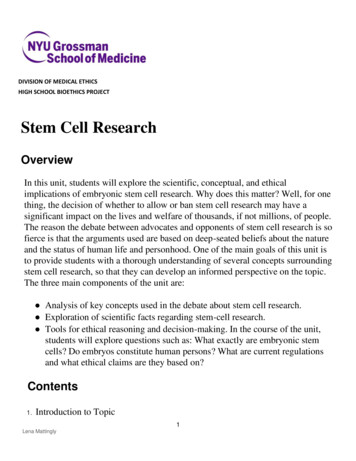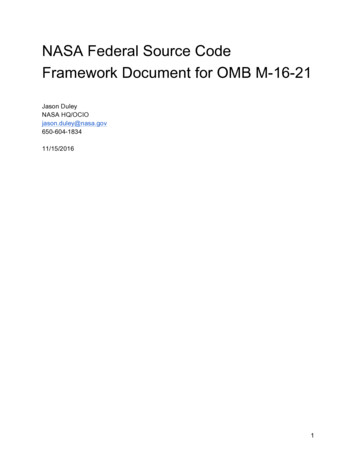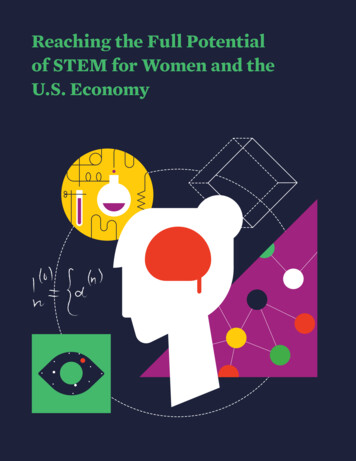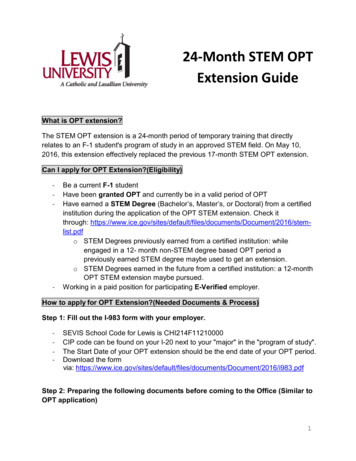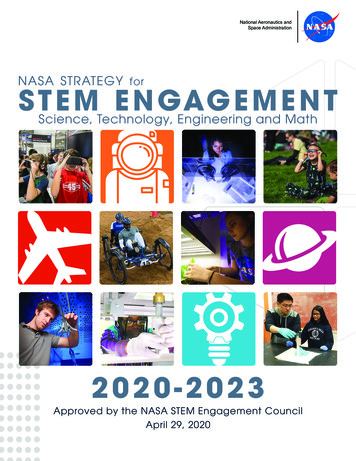
Transcription
National Aeronautics andSpace Administrationnasa strategy forS TScience,E MTechnology,E N GEngineeringAG E MENTand Math2020-2023Approved by the NASA STEM Engagement CouncilApril 29, 2020
PURPOSE AND SCOPEThe NASA Strategy for Science, Technology, Engineering and Mathematics (STEM) Engagementserves as a roadmap to frame and guide the Agency’s work to benefit students over the next threeyears. The scope of STEM engagement encompasses all endeavors Agency-wide to attract, engageand educate students and to support educators, educational institutions, and professional andstudent organizations. STEM engagement is comprised of a broad and diverse set of programs,projects, activities and products developed and implemented by Headquarters functional offices,Mission Directorates and Centers.This strategy builds on the direction and solid foundation defined and executed via the NASAStrategy for STEM Engagement (2018-2020), and aligns with the Federal Strategy for STEMEducation and Engagement (2018-2023), Charting a Course for Success: America’s Strategy forSTEM Education.The NASA Strategy for STEM Engagement provides the context for STEM engagement within theNASA strategic plan, and describes the cross-cutting design principles foundational to this work. Itserves as the framework for the Agency to provide immediate benefits to students, educators, andeducational institutions, and to help build the next generation of explorers with the technical skillsneeded to continue pursuing NASA’s mission.NASA’s STEM Engagement community works in close collaboration with NASA’s STEM workforceto provide exceptional experiences for students, and with NASA’s public engagement workforceto leverage opportunities for reaching students. NASA is committed to finding innovative ways todeliver content and engage students in STEM learning.The NASA Strategy for STEM Engagement 2020-2023 serves as the roadmap for the Agency’s workdevoted to STEM engagement, with defined objectives and strategies to drive requirements andalignment of all STEM engagement efforts, including programs, projects, activities and products.2
NASA VISION AND MISSION FOR STEM ENGAGEMENTThe vision, mission and strategic goals for STEM Engagement drive asystematic approach to move students across a spectrum of learningto inspire, engage, educate and eventually employ.VISIONWe immerse students in NASA’s work, enhance STEMliteracy and inspire the next generation to explore.MISSIONWe engage students in NASA’s mission.S T R AT E G I C G O A L SSTRATEGIC GOAL 1.0:Create unique opportunitiesfor a diverse set of studentsto contribute to NASA’s workin exploration and discovery.STRATEGIC GOAL 2.0:Build a diverse future STEMworkforce by engagingstudents in authentic learningexperiences with NASA’speople, content and facilities.STRATEGIC GOAL 3.0:Attract diverse groups ofstudents to STEM throughlearning opportunities thatspark interest and provideconnections to NASA’smission and work.NASA’s unique contributions are vital to attracting the next generation of STEMprofessionals who will continue the nation’s legacy of exploration and discovery.3
STEM ENGAGEMENT BENEFICIARIESNASA’s work in STEM Engagement is focusedon ultimately serving students. It is recognizedthat providing support and resources toeducators and educational institutions is vitalto effectively engage students.Ultimately, the beneficiaries of NASA’sinvestments and work in STEM Engagementare students in grades K-12, undergraduateand graduate levels.K-12UNDERGRADUATEGRADUATESTEM ENGAGEMENT ARCHITECTURECentral to this strategy, our architecture is designed to enable relevant student contributions toNASA’s mission and work, which relies on mission drivers and requirements from NASA’s MissionDirectorates. This will facilitate alignment of the appropriated STEM Engagement program, as wellas existing and emerging relevant projects, activities and products across the Agency, resulting in aframework and strategy with more effective and coherent approaches and outcomes.IntegratedoperationalmodelSTRATEGIC GOAL 3.0:Attract diverse groups of students toSTEM through learning opportunitiesthat spark interest and provideconnections to NASA’smission and workStudentcontributions toNASA’s work inactionK-ElementarySchoolMiddle SchoolbENEficiAriES Of NASA’SSTEM ENgAgEMENT pOrTfOliOSTRATEGIC GOAL 2.0:Build a diverse future STEMworkforce by engaging students inauthentic learning experiencesNASA-uniquelearningexperiencesHigh dergraduateEvidence-basedstrategiesSTRATEGIC GOAL 1.0:Create unique opportunities for adiverse set of students to contributeto NASA’s work in exploration anddiscoveryGraduateNASA MiSSiON dirEcTOrATEdrivErS & rEquirEMENTSNASA STEM ENgAgEMENT ArchiTEcTurEENAbliNg STudENT OppOrTuNiTiES & cONTribuTiONSScalability to magnify naSa’S reach and impactN A S A S T R AT E G Y F O R S T E M E N G A G E M E N T4
STRATEGIC GOALS, OBJECTIVES AND STRATEGIESSTRATEGIC GOAL 1.0: Create unique opportunities for a diverse set ofstudents to contribute to NASA’s work in exploration and discovery.OBJECTIVES:1.1 Provide student work experiences that enable students to contribute toNASA’s missions and programs, embedded with NASA’s STEM practitioners.1.2 Create structured and widely-accessible, experiential learningopportunities for students to engage with NASA’s experts and help solveproblems that are critical to NASA’s mission.STRATEGIC GOAL 2.0: Build a diverse future STEM workforce by engagingstudents in authentic learning experiences with NASA’s people, contentand facilities.OBJECTIVES:2.1 Develop and deploy a continuum of STEM experiences through authenticlearning and research opportunities with NASA’s people and work to cultivatestudent interest, including students from underrepresented and underservedcommunities, in pursuing STEM careers and foster interest in aerospacefields.2.2 Design the portfolio of NASA STEM engagement opportunities tocontribute toward meeting Agency workforce requirements and serving thenation’s aerospace and relevant STEM needs.STRATEGIC GOAL 3.0: Attract diverse groups of students to STEM throughlearning opportunities that spark interest and provide connections to NASA’smission and work.OBJECTIVES:3.1 Develop and deploy targeted opportunities and readily available NASASTEM engagement resources and content, to attract students to STEM.3.2 Foster student exposure to STEM careers through direct and virtualexperiences with NASA’s people and work.5
Strategies We Will Employ Toward Achieving Our Strategic GoalsHigherEducation1. Provide internships, fellowships, and other experiences for studentsto conduct scientific and technical research and perform design anddevelopment activities to fulfill NASA needs and priorities.2. Create challenges, competitions and other transdisciplinaryexperiential learning opportunities to enhance STEM student studies.1. Develop and deploy evidence-based opportunities to engage studentsin NASA-unique learning experiences beyond the classroom.K-122. Enhance student STEM experiences in schools and other educationalvenues, using evidence-based strategies, NASA STEM practitioners,learning opportunities, content and resources.3. Create and deploy authentic learning experiences and researchopportunities for students to bolster their STEM studies and stimulatefurther interest and achievement.1. Create mission-driven opportunities and collaborative initiativesthat enable institutions to conduct innovative research, design andtechnology development to address discrete NASA needs.Institutionaland EducatorSupport2. Provide direct support to colleges and universities to strengthenresearch and development capacity and capabilities that stimulatecontributions critical to NASA’s mission.3. Provide competitive opportunities for informal educational institutionsand networks to reach and engage students.1. Build and sustain a network of strategic partnerships with industry,educational institutions and informal education organizations toenhance the impact of NASA’s investments and drive delivery of NASASTEM engagement services and products.Cross-Cutting2. Increase visibility of and accessibility to NASA’s portfolio of STEMengagement opportunities and activities to broaden participationthrough the use of innovative media tools and platforms.3. Cultivate and develop opportunities to leverage NASA’s STEMworkforce, to actively participate in the Agency’s STEM engagementactivities, and serve as mentors and role models.4. Engage NASA human capital and aerospace industry leaders toidentify workforce trends and mission priorities to influence thedirection of current and future programming.6
STEM ENGAGEMENT DESIGN PRINCIPLESAt the core of NASA’s efforts in STEMEngagement are the following cross-cuttingdesign principles. These principles guidethe STEM engagement community in theplanning and execution of work in directsupport of achieving the objectives.Design PrincipleDefinitionMission-drivenauthentic STEMexperiencesDesign experiential opportunities, design and developmentactivities, research experiences, and/or products to enablestudents to contribute to NASA’s endeavors in exploration anddiscovery, and help solve problems and address needs andpriorities that are critical to NASA’s mission.Evidence-basedpracticesUse guidelines, strategies, frameworks, and proven practicesinformed by research, literature reviews, and/or evaluation tobuild the available body of facts (evidence) confirming programeffectiveness and impact.Diversity andinclusionInfuse objectives and target strategies, where practicable, toattract and sustain diversity in student participation, and toincorporate approaches to foster and promote inclusion.Scalability throughpartnerships andnetworksIncorporate in the design of an activity or product, whereappropriate, attributes and characteristics that provideopportunities to leverage partnerships and networks in orderto magnify reach and impact.Outcome-drivenEstablish outcomes and define corresponding metrics andmeasures to demonstrate success.7
STEM ENGAGEMENT IN THE CONTEXT OF NASA’S MISSIONGiven the state of the nation’s STEM workforce and projected demands in order to meet futureneeds, NASA clearly has a vested interest in helping to prepare and attract its future STEMprofessionals. Recent national and international tests show that in the last decade, U.S. studentshave demonstrated little or no growth in mathematics and remain ranked in the middle of advancedeconomies on international science and mathematics assessments1. The number of women andunderrepresented minorities earning STEM degrees has grown in broad science and engineeringoccupations over the last decade, however significant underrepresentation remains in areas criticalto NASA like engineering and computer and mathematical sciences2. Building upon strategiesand design principles identified in the STEM Engagement Strategy, NASA is positioned within thenation’s STEM ecosystem to collaborate with other federal agencies, state and local government,industry, institutions and the non-profit sector to contribute to a shared goal of a globally competitiveworkforce.NASA’s unique contributions are vital to attracting and building a vibrant and diverse next generationSTEM workforce that will continue the nation’s legacy of exploration and discovery. To execute itsSTEM engagement efforts, NASA will leverage its community of talented and dedicated educationprofessionals, and its technical workforce, who together can inspire and engage youth and studentsin STEM.U.S. STEM Challenges U.S. PISA (2018) scores 25th internationallyProjected STEM R&D job growth 8.9% (2024)Women in S&E occupations 29%Underrepresented minorities in S&E 13%below their share of college educated workforce (17%)NASA & AerospaceWorkforce Needs NASA workforce average age: 48.9 Diverse pipelineNASA Mission NeedsStudents & EducationalInstitutions Research Technology development Operations Authentic STEM learning experiences Research opportunitiesNSF Science and Engineering Indicators 2020NASA’s Contributions to the STEM Ecosystem1Science Board, National Science Foundation. 2020. Science and Engineering Indicators 2020: The State of U.S Science and Engineering.NSB-2020-1. Alexandria, VA. Available at https://ncses.nsf.gov/pubs/nsb20201/.2National Science Foundation, National Center for Science and Engineering Statistics. 2019. Women, Minorities, and Persons with Disabilities in Science and Engineering:2019. Special Report NSF 19-304. Alexandria, VA. Available at https://www.nsf.gov/statistics/wmpd.8
SUMMARYOver the next three years, NASA is committed to defining and implementing a portfolio ofSTEM Engagement programs, projects, activities and products directed toward achieving theobjectives and strategies above, driving a coherent and coordinated set of activities across theAgency. Ultimately, the work dedicated to this strategy will contribute to achieving NASA’s STEMEngagement vision to immerse students in NASA’s work, attract students to STEM, and inspire thenext generation to explore.NASA’s bold mission and the nature of its innovative and pathfinding endeavors have the potentialto inspire and engage youth and students to dream and pursue amazing goals. NASA is makingvaluable contributions to the federal sector’s goals for STEM education by providing mission-drivenopportunities that will attract students to STEM and help build a vibrant and diverse next generationSTEM workforce.Imagine America’s young people not only excited about their space program and moreknowledgeable of our nation’s work in air and space, but as a result of NASA’s STEM Engagementefforts, mobilized to pursue STEM careers and actively engaged in working toward being scientists,engineers, explorers and astronauts.National Aeronautics and Space AdministrationNASA Headquarters300 E Street SWWashington, DC -2856-HQ
NASA's STEM Engagement community works in close collaboration with NASA's STEM workforce to provide exceptional experiences for students, and with NASA's public engagement workforce to leverage opportunities for reaching students. NASA is committed to finding innovative ways to deliver content and engage students in STEM learning.

